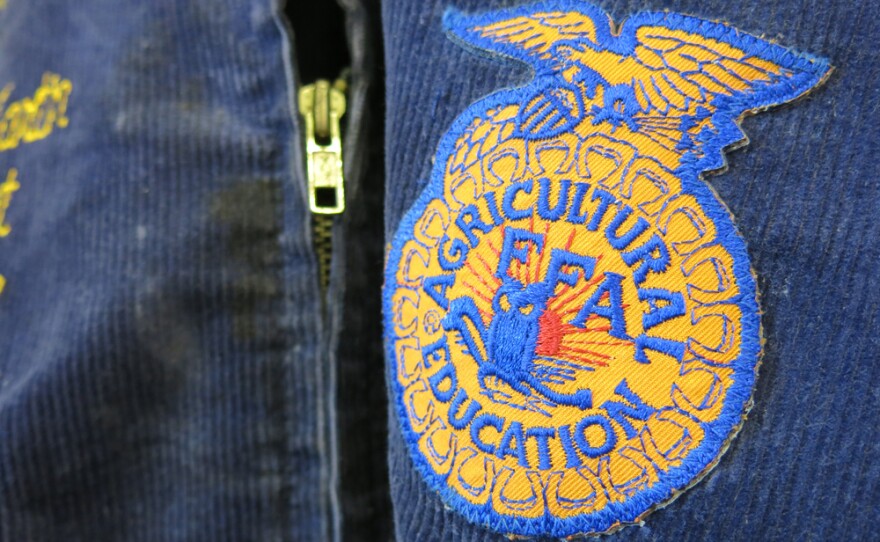The blue corduroy jacket worn by high school students in FFA, formerly the Future Farmers of America, is an icon of rural life. To the average city dweller the jacket is a vestige of dwindling, isolated farm culture, as fewer and fewer young people grow up on farms. The numbers tell a different story however. In spite of that demographic shift, a record number of kids are donning blue jackets this year.
From 2007 to 2012 the U.S. lost almost 100,000 farms, according to recent census data. While during the same period FFA enrolled an additional 60,000 students, and opened new chapters, bringing the organization to its highest number of students in its almost century-old history, just shy of 580,000.
That’s a lot of blue corduroy jackets.
Those involved with FFA tout the record enrollment as a testament to the organization’s nimbleness in the face of an increasingly urbanized society.
“The perception is that FFA is plows, cows and sows,” said Dwight Armstrong, National FFA Organization CEO. Instead of spending classroom time solely devoted to agrarian topics, chapters and school districts are choosing a more diverse curriculum. And the changing focus appears to be working. Inner city chapters in places like Chicago, Philadelphia and New York are some of the fastest growing in the country.
“Now we talk about not vocational agriculture, but the science of agriculture and the science of food,” Armstrong said.
In those technology and science-heavy topics, Armstrong said teachers can begin to point students on more stable career paths – something that couldn’t be said during the 1980s farm crisis. That’s when enrollment numbers slumped, chapters closed, the name went from Future Farmers of America to National FFA Organization, and the group’s philosophy shifted to “adapt or die.”
That’s evident in agriculture instructor Lauren Hart’s classroom in Longmont, Colo. It looks out onto the St. Vrain Valley School District’s working farm, where students get hands-on learning with cows, chickens and pigs.
Move inside the classroom walls and lessons include law, policy, entrepreneurship and bookkeeping, all with an agricultural touch. When she’s planning a curriculum, Hart said she tries to reach further into areas you wouldn’t typically associate with farming.
“The interest and the ability both of students going into production agriculture is declining,” Hart said. “It’s just not something that a high school student either wants to or thinks they can get into.”
Since she’s been teaching agriculture for eight years and was part of a Colorado FFA chapter when she was in high school. In that time, Hart said she’s noticed a shift. A greater number of students are interested in contemporary food trends, wanting to know more about organic foods and cage-free, grass-fed meat. Hart said she can’t just ignore what students want to learn about.
The millennial generation is one step removed from the farm and their interests are different notes Kenton Ochsner, Colorado’s FFA advisor.
“The industry’s changed,” Ochsner said. “And our students have changed.”
That’s why many school districts and their affiliated FFA chapters are going to great lengths to make agriculture appeal to more students.
“Now, it’s the hot topic. And parents in town want their sons and daughters to feel the land and to feel soil between their hands and to have an understanding of where their food comes from,” Ochsner said.
The pitch worked on 18-year-old Reece Melton, St. Vrain Valley FFA president. While his family has agricultural roots, he grew up in nearby Erie, Colo. Being one generation away from the farm is a common theme among the 60 other students in his chapter.
“We’re in an urban area, so most of our members do not grow up on property, though they still have that connection to agriculture,” Melton said.
Other historically rural organizations have struggled with dramatic social change over the decades. Even though FFA is enjoying a resurgence after the 1980s farm crisis, it’s still felt some growing pains as it figures out what students actually want to learn about and what’s still relevant.
A group like FFA brings in new blood on a yearly basis. Most active members are younger than 22 years old. That youthful energy gives FFA an edge over other rural, farm-related organizations, said Mike Martin, who studies agricultural education programs at Colorado State University.
“There are success stories and then there are maybe not so successful stories, and I don’t want to call it failure, but it’s sort of a struggle to adapt,” Martin said.
It’s about finding an appropriate balance between new ideas and old traditions. The most visible tradition in FFA is the blue corduroy jacket, a symbol of pride for students who spend enough time in the organization to earn one. It’s an enduring tradition as well, never changing through the years said Samuel Johnson, St. Vrain Valley FFA treasurer.
“It’s always been blue corduroy, same emblem and everything,” Johnson said.
A static symbol of tradition in an organization that’s been forced to adapt to stay relevant.
Harvest Public Media, based at KCUR, is a collaborative public media project that reports on important agricultural issues in the Midwest. You can read more about the project on their website.






